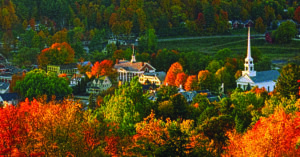New England was hit especially hard by the COVID-19 outbreak, which has severely limited the flow of visitors since March 2020. Historic and beautiful, this region is comprised of Connecticut, Maine, Massachusetts, New Hampshire, Rhode Island and Vermont. New England is notable for its coastline, unique fishing villages, rural towns, colorful fall foliage and historic landmarks.
The region is dominated by the Boston metro area with a population of roughly 5 million people. The Massachusetts economy is larger than the other New England states combined in terms of real gross domestic product (GDP). Generally speaking, wages in New England are higher than the national average, but so are the taxes, housing prices and costs of living. Some zip codes in this region are among the wealthiest in the country, whereas other areas suffer from significant income inequality and poverty.

During the depths of the coronavirus-induced economic collapse, GDP plunged into negative territory in each of these states. Quarterly GDP declines ranged from -31.1% in Connecticut to -38.2% in Vermont in second-quarter 2020. One bright spot is the region’s unemployment rates had fallen steeply as of this past October after reaching double-digit highs in the spring.
The economies of the New England states are quite diverse. Several Fortune 500 companies, including General Electric and Liberty Mutual Insurance Co., are headquartered in Boston. Beantown also is home to the iconic Fenway Park, the Boston Harbor, and numerous prestigious colleges and universities such as Harvard University, the Massachusetts Institute of Technology and Boston College.
Connecticut has the second-largest economy in New England with a GDP of $288 billion in 2019. More than half of the state’s electricity is generated by the Millstone Nuclear Power Station in Waterford. Connecticut also has two of the largest casinos in the U.S. by square footage with Mohegan Sun and the Foxwoods Resorts Casino.
Maine’s largest city is Portland. The state is by far the nation’s No. 1 producer of lobsters, an industry that has boomed in recent years. Oysters are another major export. And there are roughly 200 companies in the state engaged in shipbuilding.
Vermont, Rhode Island and New Hampshire have three of the smallest economies in the nation, ranking 50th, 44th and 39th, respectively, in real GDP among states. All three of these states rely heavily on tourism. Vermont and New Hampshire, in particular, have a year-round tourism industry that draws second-home owners from New York City and Boston in the summer, “leaf peepers” in the fall and skiers in the winter. Rhode Island is the smallest state by area, running 37 miles east to west and 48 miles north to south. ●

Key office-market fundamentals deteriorated immediately in the Greater Hartford area near the start of last year after the onset of COVID-19.
Compared to the prior quarter, the vacancy rate jumped nearly a full percentage point to 17.6% in first-quarter 2020, then remained stable in the second and third quarters of last year. Asking rents also slid by 47 cents from fourth-quarter 2019 to $20.33 per square foot as of first-quarter 2020 but then held firm through this past September.
The Hartford market, however, was struggling somewhat before the pandemic. According to Cushman & Wakefield, the market saw negative net absorption for five consecutive quarters through second-quarter 2020.
The vacancy rate in the second quarter of last year was well above the national average of 13.7%. At the end of 2019, several of the city’s largest employers were consolidating in order to “rightsize” their office footprints in the metro area.
Focus: Tourism
Tourism is a four-season industry throughout New England. This is one of the reasons why this region was so affected by the COVID-19 pandemic. Boston alone draws nearly 20 million domestic visitors and 3 million international visitors each year.
Tiny Rhode Island, meanwhile, saw nearly 25 million visitors in 2017, including roughly 8 million overnight visitors. In 2017, tourists there generated $775 million in state and local taxes. That was the equivalent of $1,890 in taxes for each Rhode Island household, Tourism Economics reported.
In Vermont, New Hampshire and Maine, tourism accounts for significant chunks of overall GDP. Annual tourism revenues are about $2.8 billion in Vermont and $6.2 billion in Maine, while some 48,000 jobs in New Hampshire are tied to tourism. Skiing is a popular pastime throughout the region and the Bretton Woods resort in New Hampshire’s White Mountains was rated the 12th-best in the world in 2019, according to Conde Nast Traveler.
What the locals say
“When you’re talking about Hartford and Connecticut, you’re wedged between New York and Boston, so there’s no question we are influenced by those markets. When you look at tourism, Connecticut has some of the biggest casinos in the world, so those markets have gotten hit by COVID. I would not say we’re insulated by any means, but I don’t think we experience the highs and the lows of the regular markets, in my opinion. It’s a little more stable. But I could tell you that Connecticut has had some challenges. We have our budget challenges. As for taxes, we’re right there with the rest of New England and the Northeast — New York and New Jersey included.”

Mark Duclos
President,
Sentry Commercial
3 Cities to Watch
Providence
 Situated in the Narragansett Bay on land first settled in 1636, Providence is the state capital and the largest city in Rhode Island with a population of 179,000 residents. The city is home base to several large companies, including United Natural Foods and Citizens Financial Group. Recent census data suggests, however, that 26% of the population was living at or below the poverty line.
Situated in the Narragansett Bay on land first settled in 1636, Providence is the state capital and the largest city in Rhode Island with a population of 179,000 residents. The city is home base to several large companies, including United Natural Foods and Citizens Financial Group. Recent census data suggests, however, that 26% of the population was living at or below the poverty line.
Manchester
 First settled in 1722 and called Old Harry’s Town, New Hampshire’s largest city now has a population of 113,000 and nearly 420,000 metro-area residents. Once home to the largest textile manufacturer in the world, the city’s economy is now driven by tech companies and higher education, the latter of which is influenced by the University of New Hampshire and nearby Southern New Hampshire University. There are 25 distinct neighborhoods recognized by the city government.
First settled in 1722 and called Old Harry’s Town, New Hampshire’s largest city now has a population of 113,000 and nearly 420,000 metro-area residents. Once home to the largest textile manufacturer in the world, the city’s economy is now driven by tech companies and higher education, the latter of which is influenced by the University of New Hampshire and nearby Southern New Hampshire University. There are 25 distinct neighborhoods recognized by the city government.
Stamford
 The second-largest city in Connecticut (population 131,000) is home to several large companies, including Charter Communications, Synchrony Financial and Vineyard Vines. Stamford also is one of the wealthiest cities in the country. The median household income in Stamford is $89,309 and the median home value is $526,700, well above national averages. The city touts a number of attractions, including its quality restaurants, live music, parks and a boardwalk.
The second-largest city in Connecticut (population 131,000) is home to several large companies, including Charter Communications, Synchrony Financial and Vineyard Vines. Stamford also is one of the wealthiest cities in the country. The median household income in Stamford is $89,309 and the median home value is $526,700, well above national averages. The city touts a number of attractions, including its quality restaurants, live music, parks and a boardwalk.
Sources: Britannica.com; Cushman & Wakefield; Daily Hampshire Gazette; Encyclopedia.com; Forbes; Institute for Energy Research; Maine Office of Tourism; My Manchester; New Hampshire Division of Travel and Tourism Development; Patch.com; Reuters; ROI-NJ.com; Tourism Economics; Trading Economics; U.S. Bureau of Economic Analysis; U.S. Bureau of Labor Statistics; U.S. Census Bureau; U.S. Department of Labor; Vermont Agency of Commerce and Community Development; WorldAtlas.com; World Population Review





